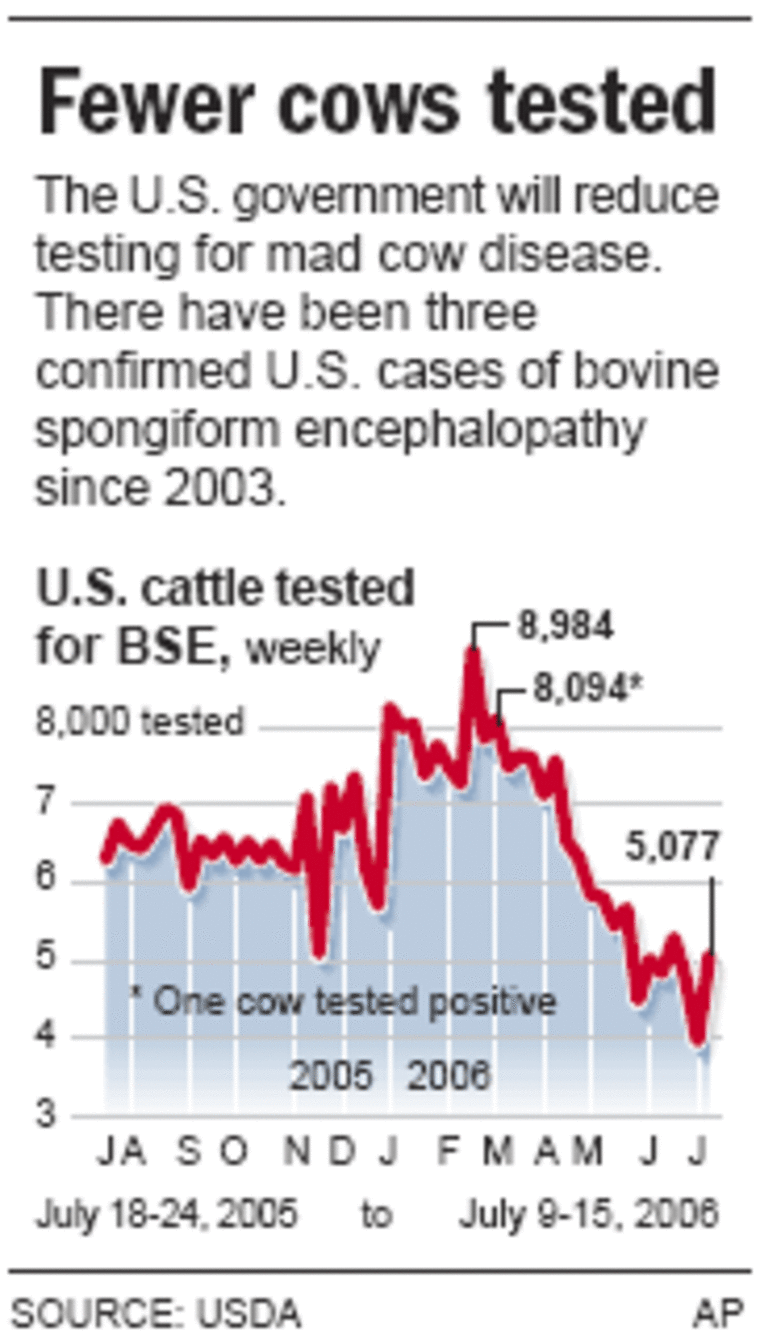The Agriculture Department is cutting its tests for mad cow disease by about 90 percent, drawing protests from consumer groups.
The current testing level — 1,000 each day — reflects the heightened concern that followed the discovery in December 2003 of mad cow disease in the United States.
Since then, tests have turned up two more cases of the disease, known medically as bovine spongiform encephalopathy, or BSE. The government says there may be a handful of undetected cases.
“It’s time that our surveillance efforts reflect what we now know is a very, very low level of BSE in the United States,” Agriculture Secretary Mike Johanns said Thursday. “There is no significant BSE problem in the United States, and after all of this surveillance, I am able to say there never was.”
Critics say now is not the time to scale back on the testing, which has cost the government an estimated $1 million per week.
“It surely will not encourage consumers in the U.S. or Japan to rush to the store to buy more beef,” said Carol Tucker-Foreman, food policy director for Consumer Federation.
A second group, Consumers Union, advocates testing every animal slaughtered in the United States.
The current level of 1,000 tests each day represents about 1 percent of the 35 million cattle slaughtered annually in this country. Beginning around late August, the new level will be about 110 tests per day.
“If you do testing of 100 percent of your animals, any ones that test positive never go into the food chain,” said Michael Hansen of Consumers Union. “That’s in part why they do it in Europe because they’ve seen animals that look perfectly fine and they catch them just before they go to slaughter.”

Johanns said testing has nothing to do with the safety of U.S. beef for consumers in the U.S. and abroad. From a food safety standpoint, the real key is removing at slaughter those cattle parts known to carry mad cow disease, Johanns said.
“Those who are trying to convince their consumers that universal testing or 100 percent testing somehow solves the problem really are misleading you,” he said.
“Consumers should feel better than ever about the meat that they are buying,” Johanns said.
His comments were applauded by industry groups such as the National Cattlemen’s Beef Association. It noted that the new level of testing, about 110 per day, is significantly higher than what is called for by the World Organization for Animal Health. Many countries follow the organization’s guidelines on testing, trade and other policies.
“In addition, our food supply remains safe from BSE thanks to extensive protective measures already in place,” said Gary Weber, executive director of regulatory affairs for the association.
Johanns said he hopes the reduction will not affect negotiations on resuming beef trade with Japan, which has pushed for the same number of tests or more. Japan was a huge consumer of U.S. beef before the first American case of mad cow disease.
Johanns said Japan, which has found 27 cases of mad cow disease, definitely has a problem with mad cow disease.
In contrast, the United States has a much larger herd of cattle and has found three cases of the disease: In December 2003, in a Washington state cow imported from Canada; last June, in a Texas-born cow; and in March, in an Alabama cow.
Johanns said Japan should “recognize that what we’ve done here exceeds all the international standards, and the markets should be open to our beef.”
Iowa Sen. Tom Harkin said he hoped Johanns was right but that “the Japanese appear ready to take advantage of any gap as an excuse to drag out this trade dispute further.”
Harkin, senior Democrat on the Senate Agriculture Committee, has questioned the accuracy of the department’s testing data.
In April, Johanns released a department analysis of testing data, saying the prevalence of mad cow disease “is extraordinarily low.” There are probably four to seven undetected cases of the disease in the U.S., according to the analysis.
A panel of three independent scientists finished reviewing the department’s analysis this month. Two of the scientists agreed that the new level of testing is sufficient. The third said the level may be sufficient but that the department needs to do a better job of getting accurate ages for cows that are tested.
The brain-wasting disorder infected more than 180,000 cows and was blamed for more than 150 human deaths during a European outbreak that peaked in 1993.
Humans can get a related disease, variant Creutzfeldt-Jakob Disease, by eating meat contaminated with mad cow.